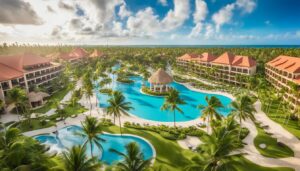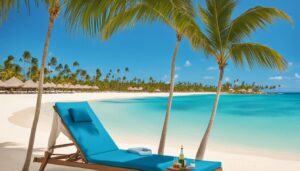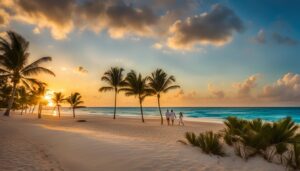Welcome to Punta Cana, a tropical paradise renowned for its pristine beaches and crystal-clear waters. However, like many coastal destinations, Punta Cana experiences a seaweed season that can impact the beach experience for visitors. If you’re planning a trip to this beautiful destination, it’s important to be aware of the seaweed season and how it can affect your beach vacation. In this article, we will provide you with valuable tips and information to help you navigate the seaweed season in Punta Cana and ensure a perfect beach experience.
Key Takeaways:
- The seaweed season in Punta Cana is more prevalent during the summer months and into fall, with the highest concentrations typically occurring in June, July, and August.
- The best time to visit Punta Cana to avoid seaweed is from November to January, as these months historically have the least concentration of sargassum.
- Seaweed is primarily found on the east, south, and north-facing beaches in Punta Cana, while west-facing beaches are less affected.
- Seaweed is not harmful to human health, but it can emit an unpleasant odor as it decomposes on the beach.
- There are ways to avoid seaweed during your Punta Cana holiday, such as choosing beaches with sea barriers and hotels that clean the shoreline regularly.
As you can see from the image above, Punta Cana’s beaches are a true tropical paradise. Now, let’s delve deeper into the world of seaweed and explore how you can make the most of your beach vacation in Punta Cana.
What is Seaweed?
Seaweed in the Caribbean refers to various species of marine algae, with the most common being Sargassum. Seaweed is an essential part of the marine ecosystem, providing habitat and food for marine life. Sargassum is known for its distinctive floating mats and is primarily found in the Sargasso Sea, east of the Caribbean. Seaweed blooms occur in the open waters of the Atlantic Ocean and can be carried by ocean currents to the Caribbean, leading to accumulations on beaches.
Seaweed is a type of marine algae that plays a vital role in the underwater ecosystem. It is characterized by its unique ability to grow and survive in saltwater environments. Seaweed is considered a macroalgae, meaning it is visible to the naked eye and can grow quite large. It can range in size and color, with some species growing only a few centimeters long, while others can span several meters.
There are various types of seaweed found in oceans around the world. Each type has its own unique characteristics and serves a specific purpose in the marine ecosystem. Some common types of seaweed include:
- Kelp: Large, brown seaweed commonly found in colder, nutrient-rich waters.
- Nori: Thin, edible seaweed commonly used in sushi rolls.
- Dulse: Red seaweed with a soft texture and a taste similar to bacon.
- Wakame: Seaweed commonly used in Asian cuisine, particularly in soups and salads.
- Bladderwrack: Brown seaweed with air-filled bladders that help it float in the water.
Sargassum is a specific type of seaweed that is known for its distinctive floating mats. It is primarily found in the Sargasso Sea, an area in the Atlantic Ocean east of the Caribbean. Sargassum blooms can occur in the open waters of the Atlantic Ocean and can be carried by ocean currents to the Caribbean, leading to accumulations on beaches. These seaweed blooms are a natural phenomenon and play an important role in providing habitat and food for various marine species.
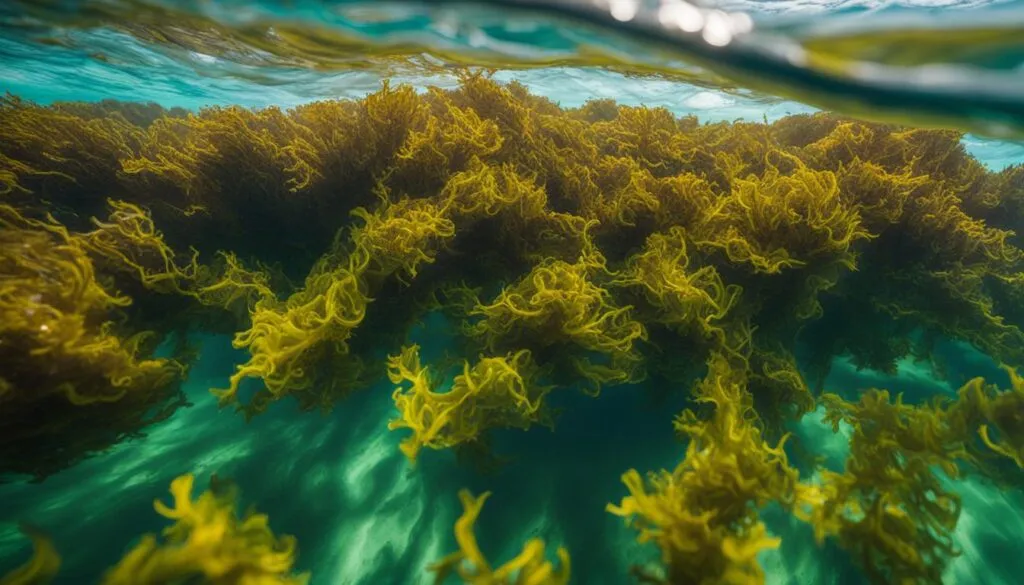
Where is Seaweed Found?
If you’re wondering where to find seaweed, you’ll discover it on many beaches in Punta Cana, as well as in other Caribbean destinations, Mexico, Florida, and Central America. In Punta Cana specifically, seaweed is more predominant on the east, south, and north-facing beaches. These areas are more affected by seaweed because the currents bring sargassum from the east. However, if you prefer to visit beaches with fewer seaweed sightings, the west-facing beaches in Punta Cana are generally less affected.
Seaweed can be found washing up on the shores of popular beach destinations throughout the Caribbean region. It’s a natural occurrence that can vary in intensity from year to year. While it may be inconvenient, it’s important to note that seaweed is not harmful to human health. It may emit an unpleasant odor as it decomposes on the beach, but it poses no direct risk to beachgoers.
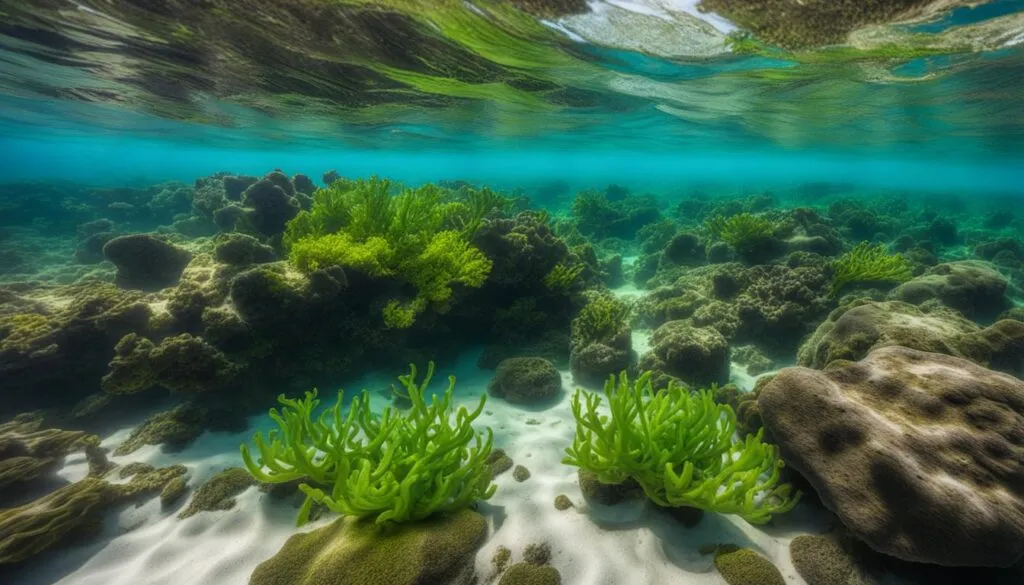
Is Seaweed Harmful?
Seaweed, including Sargassum, is not harmful to your health. In fact, it is considered a nutritious food source when consumed in appropriate quantities. Seaweed is rich in vitamins, minerals, and antioxidants, making it a beneficial addition to your diet. However, when it comes to beach conditions, there are a few concerns related to seaweed.
«Seaweed, including Sargassum, is not harmful to your health.»
The primary issue associated with seaweed is the odor that can arise as it decomposes on the beach. This odor is caused by hydrogen sulfide gas released during the decomposition process. Although it can be unpleasant, it is not directly harmful to humans.
Additionally, excessive seaweed accumulation can cover beaches, affecting their aesthetic appeal and making them less enjoyable for certain activities. This can be a drawback for beachgoers seeking pristine sandy shores.
However, it’s important to note that resorts and beach authorities are aware of these issues and take proactive measures to maintain clean and seaweed-free beaches.
| Concern | Impact |
|---|---|
| Odor | Hydrogen sulfide gas released during decomposition can create an unpleasant smell. |
| Beach Conditions | Excessive seaweed accumulation can cover beaches, making them less aesthetically appealing. |
«Excessive seaweed accumulation can cover beaches, affecting their aesthetic appeal and making them less enjoyable for certain activities.»
Resorts in seaweed-prone areas regularly maintain their beaches, ensuring a pleasant beach experience for visitors. They have cleaning protocols in place to remove seaweed, maintaining the beauty and cleanliness of the shoreline.
Remember, while seaweed may not be harmful to your health, it is essential to consider these factors when planning your beach activities. Now, let’s explore some tips on how to avoid seaweed during your Punta Cana vacation.
How to Avoid Seaweed in Punta Cana
To ensure a seaweed-free beach experience during your Punta Cana holiday, follow these helpful tips:
1. Choose beaches with seaweed barriers
Opt for beaches in Punta Cana that have installed seaweed barriers. These barriers act as a protective barrier, preventing seaweed from reaching the shore. By selecting beaches with these barriers, you can enjoy a pristine coastline without any seaweed disturbance.
2. Select hotels with effective cleaning and maintenance protocols
When looking for accommodations in Punta Cana, choose hotels or resorts that have effective cleaning and maintenance protocols for the shoreline. These establishments prioritize the cleanliness of the beach by regularly removing any seaweed that washes ashore. By staying at such resorts, you can relax on a seaweed-free beach throughout your stay.
3. Take advantage of regular beach cleaning efforts
Resorts in Punta Cana put significant efforts into minimizing the impact of seaweed on beach conditions. They conduct regular cleaning efforts to ensure a clean and seaweed-free beach for their guests. By frequenting these beaches, you can enjoy a pleasant beach experience without any interference from seaweed.
4. Maintain a safe distance from decomposing seaweed piles
While exploring Punta Cana’s beaches, remember to avoid sitting or sleeping right next to decomposing seaweed piles. These piles can emit a toxic gas as they break down, which can be harmful if inhaled. By maintaining a safe distance, you can safeguard your health and enjoy a worry-free beach vacation.
5. Stay updated on current seaweed conditions
Seaweed influxes can vary from year to year, so it is always a good idea to stay informed about the current seaweed conditions in Punta Cana. Check with local authorities, resorts, or reliable sources to get the latest updates on seaweed presence and beach conditions. This will help you plan your trip accordingly and make informed decisions.
By following these tips, you can enjoy a memorable beach vacation in Punta Cana without the hassle of seaweed.
Best Time to Visit Punta Cana for Seaweed-Free Beaches
If you’re planning a trip to Punta Cana and want to enjoy the pristine beauty of seaweed-free beaches, the best time to visit is from November to January. During these months, Punta Cana experiences the least concentration of sargassum, ensuring a more enjoyable beach experience.
Not only will you be able to bask in the warm sunshine and dip your toes in the crystal-clear turquoise waters, but you’ll also avoid the presence of seaweed that can sometimes wash ashore in other seasons.
During November to January, Punta Cana enjoys stable weather conditions, with a dry and pleasant climate. This period is perfect for sunbathing, swimming, and participating in various water activities without the worry of encountering seaweed.
However, it’s essential to note that seaweed influxes can vary from year to year, influenced by factors such as ocean currents and weather patterns. Therefore, it’s always a good idea to check the current seaweed conditions before finalizing your travel plans.
Punta Cana Weather Overview
The weather in Punta Cana is characterized by warm temperatures throughout the year, with average highs ranging from 80°F (27°C) to 90°F (32°C). The destination features a tropical climate, with a dry season from November to April and a wetter season from May to October.
During the dry season, which aligns with the best time to visit for seaweed-free beaches, you can expect minimal rainfall and plenty of sunshine. This weather allows you to soak up the sun and enjoy the beautiful coastal scenery without interruptions.
For those seeking a relaxing beach vacation with fewer crowds and a higher chance of seaweed-free shores, November to January in Punta Cana offers an ideal escape.
| Month | Average High Temperature (°F) | Average Low Temperature (°F) | Rainfall (inches) |
|---|---|---|---|
| November | 83 | 73 | 2.2 |
| December | 82 | 72 | 1.9 |
| January | 81 | 70 | 1.5 |
Source: Punta Cana Weather
Plan your visit to Punta Cana during the optimal time, and you’ll enjoy the picture-perfect beaches and alluring coastal scenery without the inconvenience of seaweed. Whether you’re lounging under the palm trees or indulging in exciting water sports, your Punta Cana getaway during November to January promises a memorable and seaweed-free experience.
Best Beaches in Punta Cana Without Seaweed
When it comes to enjoying a seaweed-free beach experience in Punta Cana, there are several gorgeous options to choose from. These beaches have gained a reputation for their pristine shores and crystal-clear waters, making them ideal for swimming, sunbathing, and relaxing without the hassle of seaweed. Whether you’re looking for a tranquil spot or a lively beach with exciting activities, Punta Cana has something for everyone.
Macao Beach
Macao Beach is a popular destination for tourists and locals alike, known for its untouched beauty and azure waters. Located on the northern coast of Punta Cana, this beach boasts picturesque landscapes, soft sand, and gentle waves. It’s an excellent spot for swimming and surfing, with stunning views that will leave you in awe.
Cabeza de Toro
If you’re seeking a secluded and pristine beach, Cabeza de Toro is the perfect choice. Situated on the eastern side of Punta Cana, this hidden gem offers tranquility and natural beauty. Its calm, turquoise waters are ideal for a leisurely swim or snorkeling adventure. Take a stroll along the shore and discover the peace and serenity that Cabeza de Toro has to offer.
Bayahibe
For those who want to venture outside of Punta Cana, a trip to Bayahibe is highly recommended. Located on the southeastern coast of the Dominican Republic, this charming fishing village is known for its pristine beaches and vibrant marine life. You can relax on the soft sands, snorkel among colorful coral reefs, or embark on a boat tour to explore the nearby islands.
Miches
If you’re in search of a hidden paradise, head to Miches. This secluded beach, situated on the northeastern coast of the Dominican Republic, offers a tranquil and mesmerizing escape from the crowds. With its palm-fringed shores and crystal-clear waters, Miches is a paradise for nature lovers and those seeking solitude.
Isla Saona
One of the most iconic and breathtaking beaches in the Dominican Republic is Isla Saona. This island paradise, located just off the southeastern coast of the country, boasts powdery white sands, turquoise waters, and a stunning coral reef. It’s a popular destination for day trips, where you can enjoy swimming, sunbathing, and exploring the vibrant marine life.
These beaches in Punta Cana provide a seaweed-free environment, allowing you to fully immerse yourself in the beauty of the Caribbean. Whether you’re looking for adventure or relaxation, these coastal paradises offer the perfect setting for an unforgettable beach experience. Remember to check current conditions before your visit to ensure the optimal beach conditions.
Best Resorts Without Seaweed in Punta Cana
If you’re looking for a beach getaway without the hassle of seaweed, Punta Cana has some fantastic resorts that offer seaweed-free beaches. These resorts prioritize maintaining pristine shorelines for their guests to enjoy a relaxing and picturesque beach experience. Here are three of the best resorts without seaweed in Punta Cana:
1. Beaches Resorts
Beaches Resorts in Punta Cana is renowned for its stunning beaches that remain free from seaweed. As an all-inclusive resort, Beaches offers a range of amenities and activities to ensure a memorable vacation for guests of all ages. You can indulge in water sports, dine at world-class restaurants, and relax in luxurious accommodations, all while enjoying a seaweed-free beachfront.
2. Veranda
The Veranda resort in Punta Cana is another excellent choice for a seaweed-free beach experience. With its prime location on Bavaro Beach, Veranda boasts crystal-clear waters and pristine sands that are meticulously maintained. Whether you’re lounging by the pool or strolling along the beach, you can bask in the beauty of a seaweed-free environment.
3. Club Med
Club Med Punta Cana is a paradise for beach lovers seeking a seaweed-free escape. This all-inclusive resort offers a range of activities and entertainment options, including access to their immaculate beachfront. You can soak up the sun, take a refreshing dip in the turquoise waters, and unwind on the sandy shores without the presence of seaweed.
It’s important to note that seaweed conditions can vary, so it’s always recommended to check with individual resorts for the most up-to-date information on seaweed presence before making a reservation. However, you can generally trust the commitment of these resorts to deliver a seaweed-free experience for your ultimate beach vacation in Punta Cana.
Picture yourself lounging on the pristine beaches of Punta Cana, free from the intrusion of seaweed. Experience the true beauty of this tropical paradise by choosing one of the best resorts without seaweed in Punta Cana. Enjoy the splendor of turquoise waters and powdery white sands as you create unforgettable memories in this beach lover’s haven.
Conclusion
Navigating the seaweed season in Punta Cana can be easier with the right information and tips. While seaweed influxes can vary from year to year, the best time to visit Punta Cana for seaweed-free beaches is from November to January. During this period, you can enjoy the stunning turquoise waters and sandy beaches without the presence of seaweed.
To enhance your beach experience in Punta Cana, consider choosing beaches with sea barriers and resorts that prioritize regular shoreline cleaning. These measures help to keep the beaches clear of seaweed, allowing you to relax and soak up the sun without any interruptions. Remember to check with individual resorts for current seaweed conditions before making a reservation.
There are specific beaches and resorts in Punta Cana that are known for being relatively free of seaweed. Beaches like Macao, Cabeza de Toro, Bayahibe, Miches, and Isla Saona are popular choices. These locations have natural barriers and are less affected by seaweed, ensuring a more pleasant beach experience.
By being well-informed and prepared, you can make the most of your beach vacation in Punta Cana. With the right timing, careful selection of beaches, and a knowledgeable choice of resorts, you can enjoy the beauty of Punta Cana’s beaches, indulge in water activities, and create unforgettable memories, all while avoiding the presence of seaweed. Have a fantastic time exploring the idyllic shores of Punta Cana!
FAQ
When is the seaweed season in Punta Cana?
The seaweed season in Punta Cana can vary from year to year, but historically, the seaweed influx is more prevalent during the summer months and into fall. The peak of the sargassum season in the Caribbean is generally observed between April and September, with the highest concentrations often occurring in June, July, and August. However, seaweed influxes can vary from year to year.
Where can seaweed be found in Punta Cana?
Seaweed in Punta Cana is primarily found on the east, south, and north-facing beaches, while west-facing beaches are less affected. Seaweed can be found on many beaches in Punta Cana, as well as in other Caribbean destinations, Mexico, Florida, and Central America.
Is seaweed harmful?
Seaweed, including Sargassum, is not harmful to human health. It is considered a nutritious food source when consumed in appropriate quantities. The primary concerns related to seaweed are the odor that can occur as it decomposes on the beach and the impact on beach conditions.
How can I avoid seaweed in Punta Cana?
To avoid seaweed during your Punta Cana holiday, you can choose beaches with sea barriers that prevent the seaweed from reaching the shore. Additionally, selecting hotels or resorts that have effective cleaning and maintenance protocols for the shoreline can help ensure a seaweed-free beach experience.
When is the best time to visit Punta Cana for seaweed-free beaches?
The best time to visit Punta Cana for seaweed-free beaches is from November to January. Historically, these months have the least concentration of sargassum in Punta Cana. However, seaweed influxes can vary from year to year, so it’s always a good idea to check current conditions before planning your trip.
Which are the best beaches in Punta Cana without seaweed?
Some of the best beaches in Punta Cana that are relatively free of seaweed include Macao, Cabeza de Toro, Bayahibe, Miches, and Isla Saona. However, it is important to note that seaweed conditions can vary, so it’s always a good idea to check current conditions before visiting these beaches.
Are there resorts in Punta Cana without seaweed?
Yes, there are resorts in Punta Cana that are known for having seaweed-free beaches. Some of the best resorts without seaweed in Punta Cana include Beaches Resorts, Veranda, and Club Med. It’s always recommended to check with individual resorts for current seaweed conditions before making a reservation.
Is seaweed bloom a common occurrence in the Caribbean?
Seaweed blooms, including Sargassum, occur in the open waters of the Atlantic Ocean and can be carried by ocean currents to the Caribbean, leading to accumulations on beaches. Seaweed influxes can vary from year to year, causing variations in the extent of seaweed coverage in different regions.



